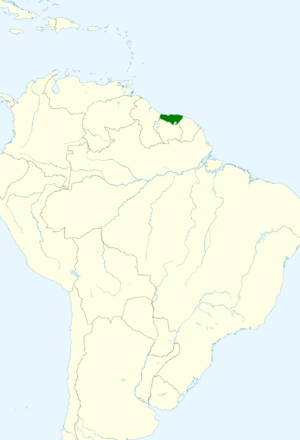Arrowhead piculet facts for kids
Quick facts for kids Arrowhead piculet |
|
|---|---|
| Conservation status | |
| Scientific classification | |
| Genus: |
Picumnus
|
| Species: |
minutissimus
|
 |
|
The arrowhead piculet (Picumnus minutissimus) is a tiny bird. It belongs to the woodpecker family. You can find it in Suriname. It might also live in French Guiana and Guyana.
Contents
What is a Piculet?
Piculets are small birds that look a lot like woodpeckers. They are part of the same bird family, Picidae. The arrowhead piculet is special because it is monotypic. This means it is the only species in its group. Some scientists once thought other piculets were part of its family. But now they are seen as different species.
What Does It Look Like?
The arrowhead piculet is very small. It is about 9 to 10 cm (3.5 to 4 inches) long. It weighs about 11 to 16 grams (0.4 to 0.6 ounces).
- Head: Males have a black cap on their head. There is a red patch on their forehead. White spots cover the rest of the cap. Their face is mostly dark brown. Some feathers have white tips. There is also a white line behind the eye.
- Body: Their upper body is olive brown. The feathers have black wedge shapes in the middle. They also have a thin black bar and a white spot near the tip. Their lower back is plainer.
- Wings and Tail: Their flight feathers are brown. They have light buffy edges. Their tail is brownish black. The inner tail feathers are mostly white. The outer two pairs have a white stripe.
- Underparts: Their chin and throat are whitish. They have blackish bars. Their belly and sides are white with a brownish tint. The feathers on their underparts have brownish black edges. This makes them look a bit scaly.
Female arrowhead piculets look just like the males. But they do not have the red patch on their forehead. Young birds have a plain brown crown. Their upper parts are browner than the adults'. They also have blackish bars. Their underparts are duller.
Where Does It Live?
Most experts agree the arrowhead piculet lives only in Suriname. Some think it might also be in nearby Guyana and French Guiana. Even though its home area is small, it lives in many different places. You can find it in:
- Mangrove forests
- Forests that have grown back after being cut down
- Plantations (areas where crops are grown)
- Forests along rivers (called gallery forests)
- Forests in the mountains
How Does It Behave?
Movement
The arrowhead piculet stays in its home area all year long. It does not migrate.
What Does It Eat?
Scientists are still learning about what the arrowhead piculet eats. But we know it likes ants and small beetles. It finds food in a special way. It hangs upside down from twigs and small branches. Then it taps on them, much like a chickadee does.
How Does It Raise Its Young?
The arrowhead piculet's breeding season is from March to December. The male bird digs a nest hole. The female helps a little bit too. They often make their nest hole high up. It can be as high as 8 meters (26 feet) above the ground.
A female piculet usually lays two or three eggs. Both parents take turns sitting on the eggs. This is called incubation. It takes about 12 to 14 days for the eggs to hatch. Both parents also bring food to the baby birds. The young birds leave the nest about 28 days after they hatch.
What Sounds Does It Make?
The arrowhead piculet makes a series of thin notes. It sounds like "it-it-it-it..." or "kee kee kee." It can make about 14 of these notes in a row. It also makes a loud chattering sound. This happens when it is fighting with another bird.
Is It Endangered?
The International Union for Conservation of Nature (IUCN) checks on animals around the world. They first listed the arrowhead piculet as "Least Concern." This means it was not in danger. Then in 2012, they changed it to "Near Threatened." But in 2019, they changed it back to "Least Concern."
Even though it lives in a small area, its population seems stable. This means the number of these birds is not going down. However, cutting down forests (deforestation) is still a threat to its home.


